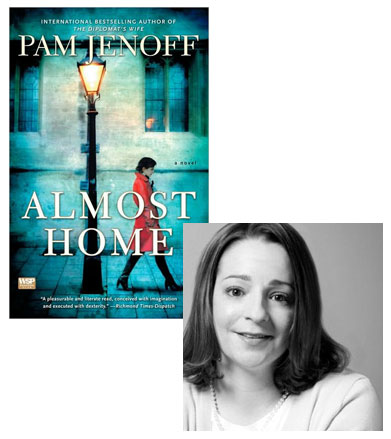Pam Jenoff and the Cambridge Story She Couldn’t Shake

I’m away at a sales conference this week, and though most of the books I’ve brought with me to read in whatever free moments I might be able to find are published by my employers, I did bring one other novel to read on my flights to and fro: Almost Home, a romantic thriller by Pam Jenoff. Pam was kind enough to share her thoughts about how she’s had the idea for this novel for a long time, and was finally able to set it down after pursuing a slightly different direction in her first two books.
Almost Home is the culmination of a vision I’ve had for more than a decade. The idea arose when I was still living in Europe in the mid-1990s. I was traveling through Spain with two friends, one Polish and one American. One night as we were lying awake in our pension talking, I began mapping out a story of a young woman whose boyfriend had died mysteriously years earlier when they were students at Cambridge. Many former Cambridge students, myself included, seemed to have complex relationships with the alma mater where they had enjoyed such deeply passionate experiences, and the death I envisioned was on some level a metaphor for those relationships. I didn’t know then that the young woman’s name was Jordan, or that she would turn out to be a diplomat, like myself at the time.
A few years later, when I returned to the States and started seriously writing novels, I was working on two ideas: one for Almost Home, which was modern, and one for The Kommandant’s Girl, which was historical. I took samples of both to my writing class and my peers liked both, but were slightly more enthusiastic about The Kommandant’s Girl, so I pursued that project and ultimately published it and the sequel, The Diplomat’s Wife
Meanwhile, the idea for Almost Home was never far from my thoughts, and I was so glad to have the chance to finally return to it and learn the many secrets and surprises the story would ultimately reveal.
There are some people who will look at the parallels between Jordan’s life and my own (Cambridge and State Department) and wonder, “How much of the story is real?” In response, I say first and foremost: It’s all fiction, the characters, the story, everything. But I believe that while real life makes terrible plot, it makes for wonderful setting. I do consider the themes of the book, love and loss and coming to terms with the past, are very “real” to me. And I do think of the book as a tribute to two groups of people: First, the many Foreign Service Officers and other government workers I’ve been privileged to know, whose heroism, skill and sacrifice continue to awe me long after our professional affiliation ended. Second, the book is ultimately a homage to the friends with whom I experienced that brief illumination of Camelot known as Cambridge, a time and place that left its mark on all of us and created a common bond that lives on. Beyond all else, Almost Home is a tribute to that real-life fairytale, and a love song to those who lived it.
I’ve been asked quite a bit about the change in genre from historical fiction to romantic suspense. I’m not a big one for labels; I don’t write for a specific genre, I write about the topics that interest me. But I do think that readers of my first two, more historical books will greatly enjoy Almost Home because it has so many of the same elements: a strong female protagonist, romance, international intrigue and adventure plus a historical back story. It similarly shares a common central theme—a young woman, facing extraordinary circumstances, who learns more about herself and her inner strength than she thought possible. Finally, Almost Home is also a passion project, conceived out of the same travels and experiences that affected me and influenced my other books so profoundly. Despite the differing time period, it really is a very similar type of book.
24 February 2010 | guest authors |

 Our Endless and Proper Work is my new book with Belt Publishing about starting (and sticking to) a productive writing practice.
Our Endless and Proper Work is my new book with Belt Publishing about starting (and sticking to) a productive writing practice. 
